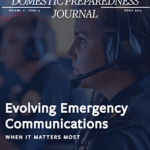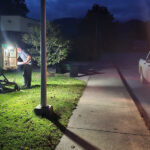- Agriculture & Food Defense, Articles, CBRNE, Communication & Interoperability, Critical Infrastructure, Emergency Management, Emergency Medical Services, Fire, Hazmat, Hospitals, Law Enforcement, Public Health, Science & Technology, Transportation
- Michael Prasad
Planning for the emergency management needs of space aliens on Earth, in terms of their well-being before, during, and after disasters could be the plot of a science fiction movie script. The movie District 9 has a similar premise: the aliens that arrived on Planet Earth were not warriors, but rather sentient beings totally reliant on help instead. The reality is there are beings like this in every community. They are called “children.”
Like the aliens in movies, children eat different foods (and in different ways than adults), have different sleep patterns, and have more energy on average than most adults (but they generally lack the same level of strength). They also grow in physical size almost exponentially. They have a great need for education. They have an uncanny ability to communicate with each other very easily, especially with nonverbal cues and signals. Many times, adults have a difficult time communicating with them. Governments at all levels have already made the decisions and commitments to completely integrate children into society, helping them to learn skills and to educate them. Families are recognized (or are established) to help them fully fit into society with everyone else. Children are vastly different from adults: laws are made, as are procedures, facilities, systems, etc. to support them in their uniqueness – yet generally those differences between adults and children are ignored during disasters.
During past emergencies and disasters, children’s issues sometimes would become a temporary priority to local and even state governments. However, during this worldwide pandemic, the specific disaster needs of all children – and their families – became a national concern. These types of disaster needs were and continue to be very different from those of adults. Emergency managers must consider the threats and hazards associated with children before, during, and after any disaster through the same planning, organization, equipping, training, and exercising – just as would be done for any other concern. These are some of the specific children-in-disaster related impacts, along the lines of the U.S. National Emergency Support Functions (ESF) and the Recovery Support Functions (RSF) – with a bit of Preparedness/Protection/Prevention and Mitigation aspects as well.
Emergency Support Functions
ESF#1 – Transportation. Specialized transportation vehicles are used for children. Transportation accidents involving these specialized vehicles are more complex than for other vehicles. There are also transportation regulations and laws related to the movement of children. For example, emergency managers may have to decide whether they would recommend the suspension of car seat and seat belt laws during an evacuation. Evacuation routes from schools and childcare facilities must be considered in reverse-lane planning – including the possibility of using those facilities as endpoint reception centers/shelters.
ESF#2 – Communications. Although there are currently no interoperability communications missions for responders to directly communicate with children (children under 18 are not generally thought of as emergency responders themselves – there are no interoperable communications concerns with children per se), one of the mass care missions is Family Reunifications Services. This can be used to reconnect children with their host families and requires dedicated communications channels to prioritize the message traffic for this mission.
ESF#3 – Public Works and Engineering. In many communities, the public-owned schools and other educational/childcare facilities are used for other non-disaster activities (e.g., voting, community meetings) and many have been designated (purpose-built, in many cases) for major disaster use since the cold-war days more than 50 years ago. K-12 schools and college/university facilities should be considered critical infrastructure/key resources (CI/KR) and designed in ways to support incident response and recovery. Public-private partnerships should be established to also utilize (and support) private schools for these same purposes. In many states, mitigation grants have already been utilized to build safer rooms within schools to protect the community from tornadoes and other weather hazards.
ESF#4 – Firefighting. Part of the skills taught to children includes fire prevention and protection. Firefighters also need training on the differences in size, cognitive skills, and language ability of children, which makes search and rescue aspects different from adults. Also, children may have a fear of firefighters and hide from rescue efforts.
ESF#5 – Information and Planning. As described here, there are many informational and incident planning differences between adults and children. Several children-specific Essential Elements of Information are noted here. TEEX has a course (MGT-439) that covers many of the medical disaster response and emergency preparedness concerns for children. Also, FEMA currently is building a five-hour needs integration course.
ESF#6 – Mass Care. Sheltering for children and their families may require special services (e.g., beds/cots, dietary needs, consumer medical supplies, durable medical equipment, personal assistance). Extra supervision is needed to protect unaccompanied children. Feeding – including mobile feeding – will also have dietary concerns for children, but probably not too different from the variants adults would need (e.g., allergies, vegetarian, kosher/halal). Distribution of emergency supplies must include special items unique to children. Family reunification services, as noted under ESF#2 is critical, especially for unaccompanied children who have been separated from their host families.
They eat different foods, have different sleep patterns, have more energy, grow exponentially, require education, and communicate using nonverbal cues and signals.
ESF#7 – Logistics. As noted under ESF#3, childcare and educational facilities and their staff may be resources available for operations. For example, many of these facilities have food service capabilities that could be used for everyone. Also, getting resources to childcare and educational facilities should be a mission priority (at the same level as restoring any other ESF or establishing a Recovery Support Function [RSF]) as the restoration of educational, health, and mental health services for children and young adults should be a federal Primary Mission Essential Function (it is not currently designated as such).
ESF#8 – Public Health. Although a child’s physiology may appear like an adult’s, it is not simply scaled by size. Medical treatments, consumable medical supplies, durable medical equipment, etc. are very different for children – and surge capacity issues during mass casualty incidents require extra/different planning, staff organization, equipment, and responder training as well as being exercised regularly. Children have physical, mental, cognitive, emotional, and other health issues that are more critical in their age bands than in adults. Operational sites such as points of distribution for mass prophylaxis and community reception centers for decontamination need to be configured for both unaccompanied children (who may need assistance from responders), as well as children with their host families.
ESF#9 – Search and Rescue. As noted under ESF#4, children may be reluctant to be rescued. They may hide or stay behind with pets. Special protective seating and carrying devices for transporting/evacuating children, are necessary for infants, toddlers, and smaller children.
ESF#10 – Oil and Hazardous Materials Response. Some high school, college, and university facilities have chemicals and other hazardous materials stored onsite for education and research purposes. Some college campuses have their own cogeneration electrical plants, others even have nuclear acceleration laboratories. Proper resource surveys need to be conducted as part of the CI/KR research and review. Grid-mapping of hazard areas, during the preparedness phase will help first responders at these facilities and complexes.
ESF#11 – Agriculture. As noted previously, the amounts and types of foods children eat can be very different from adults. Children have a strong connection with pets. There are no additional biohazard concerns for children related to the food supply, but some foodborne illnesses (e.g., listeria, salmonella) affect children more seriously.
ESF#12 – Energy. In general, there is no difference in energy usage by children. However, their facilities should be prioritized for utility restoration as any other CI/KR site. This will help continue children-in-disaster support missions, as well as provide logistics capabilities from childcare and educational facilities for other ESF use, if needed.
ESF#13 – Public Safety. The legal system treats most children under 18 years old with different laws and issues as to criminal activity. For example, during incidents, curfews may be established for children only. There are also special protection laws for children against harm or abuse, especially those who have been separated from their host families. Searching for missing children is a dedicated task force within operations and has multiple public-private partnerships involved during non-disaster times as well.
ESF#14 – Cross-Sector Business and Infrastructure. There are many people who work at childcare and educational facilities (both public and private) – many can be cross trained for disaster roles. There are also numerous support businesses associated with children. Childcare and educational facilities (both public and private-owned) should be part of the Building Resilient infrastructure and Communities (BRIC) Mitigation Planning, as their cross-functional use for supporting other ESFs can be a community asset.
ESF#15 – External Affairs. How emergency management is supporting children, their host families, facilities, etc. is no different than any other ESF or RSF. It certainly requires leadership and subject-matter expertise (SMEs) for this specific field. Public information officers (PIOs) would be strongly encouraged to understand the basics of supporting children during disasters but should also have PIO support by childcare and educational SMEs at the ready (e.g., press conferences, joint information centers).
Recovery Support Functions
Housing RSF. Children need to be considered in housing capacity, both as part of host-family sizing calculations and as collective units within any residential child support site(s) for children without host-families (e.g., group homes, orphanages). Children with disabilities also may need separate residential support sites.
Health & Social Services RSF. As a continuation beyond the response from ESFs# 6 and 8, the health and social service needs of children has been noted previously. The skills learning and education by children is a greater need than what this RSF currently is designed to support.
Community Planning and Capacity Building RSF. Childcare and educational facilities, when damaged or destroyed by a disaster – or are in insufficient quantities and capacities for post-recovery growth of a community – need to be included in the community planning process. The same is true for the support services needed, which are child-specific (e.g., medical/mental health treatment facilities, libraries).
Economic RSF. Prioritized restoration of childcare and educational facilities and support services provides three major economic benefits:
- Without these facilities, most host-families (and many emergency responders) may not be able to fully return to work since they must provide full-time care for their children.
- There are many jobs and financial support systems associated with these childcare and educational facilities. Restoring these facilities greatly supports the local economy.
- In the long run, properly educated and trained children contribute to society.
Infrastructure Systems RSF. As a continuation of ESF#3, the interagency and interjurisdictional support of both public and private childcare and educational facilities leverage innovative and green technologies and support renewed economic activity.
Natural and Cultural Resources RSF. Children and their host families benefit from restored natural and cultural resources as adults do. The significance and importance of these resources is something to share with children for long-term community well-being.
FEMA is already starting to recognize the complex aspects of supporting children in disasters. Also, the new IS-237 course introducing Deliberate Planning specifically notes that whole community planning needs to include restoring childcare and educational facilities as a community need. The points made about restoring those facilities alone, for first and emergency responders, should be a priority to sufficiently have the workforce needed to support the response and recovery from any disaster. The International Association of Emergency Managers – Children and Disasters Caucus is also working on a long-term project to amplify the disaster needs of infants, children, and young adults (from pre-K through college) to the same levels of Community Lifelines, Emergency Support Functions and/or Recovery Support Functions. Emergency managers need to consider their community’s children as unique and vital in many ways.

Michael Prasad
Michael Prasad is a Certified Emergency Manager®, a senior research analyst at Barton Dunant – Emergency Management Training and Consulting, and the executive director of the Center for Emergency Management Intelligence Research. He researches and writes professionally on emergency management policies and procedures from a pracademic perspective. His first book Emergency Management Threats and Hazards: Water was published by CRC Press in September 2024, and his second book Rusty the Emergency Management Cat is now available on Amazon to assist emergency managers in communicating with families to help them alleviate disaster adverse impacts on children. He holds a B.B.A. from Ohio University and an M.A. in emergency and disaster management from American Public University. Views expressed may not necessarily represent the official position of any of these organizations.
- Michael Prasadhttps://domesticpreparedness.com/author/michael-prasad
- Michael Prasadhttps://domesticpreparedness.com/author/michael-prasad
- Michael Prasadhttps://domesticpreparedness.com/author/michael-prasad
- Michael Prasadhttps://domesticpreparedness.com/author/michael-prasad






